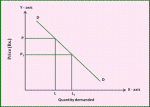The self-initiated harrowing activity associated with every course of study and often @#$%^&*((!! proclamations are heaped upon the Teacher for the examination questions being assessed.
Accept the notion of stress as an inherent by-product of examinations and the “world” mysteriously become smaller and lonesome…..you are on your own and wondering: “Why my fellow students keep on writing?, Wow!! another student asking for extra writing pads, Can you stop coughing, sniffing, clearing of throat!!………….”
and worst of all:
Success in examinations centred on : a) understand what is required via interpretation of the key task word, for example:
Define the concept of ‘Law of Demand’ in Economics theory (2 marks) which require providing a definition similar to that you would find in the glossary to your textbook.
against
Explain the concept of ‘Law of Demand’ in Economics theory (4 marks) which require a fair amount of explanation with complete thoughts, thus validating the higher marks being allocated.
b) provide evidence of understanding through your writing. An illustration of marks allocation for the range of answers to the question pose:
Explain the concept of ‘Law of Demand’ in Economics theory (4 marks).
Answer A: The law of demand states that the quantity demanded for a good rises as the price falls. (0.5 mark)
Answer B: The law of demand states that the quantity demanded for a good rises as the price falls, vice versa. (1 mark)
Answer C: The law of demand states that the quantity demanded for a good rises as the price falls, vice versa and ceteribus paribus. (1.5 marks)
Answer D: The law of demand states that the quantity demanded for a good rises as the price falls, vice versa and ceteribus paribus. This is illustrated in Figure 1 with a downward slopping demand curve. (2.5 marks)
Figure 1: Demand curve
Answer E: The law of demand states that the quantity demanded for a good rises as the price falls, vice versa and ceteribus paribus. Using apples as an example, this is illustrated in Figure 1 with a downward slopping demand curve.
Figure 1: Demand curve for apples
As seen in the diagram: When the price of apples falls from P to P1, greater quantity will be demanded which is represented by a movement along the demand curve i.e. X to X1, ceteris paribus. Similarly, should the price of apples increase from P1 to P, the quantity demanded will reduced from X1 to X, ceteris paribus. (4 marks)
To prevent such “grasping at straws answers” during examinations:
Writing exam answers (University of Reading)
http://www.rdg.ac.uk/studyadvice
Common mistakes made by students in examinations
http://www.theguardian.com/education/2013/apr/30/student-advice-exams-success
http://www.sgbox.com/studyskill9.html
Techniques that have served me well in examinations:
- I have never been late nor left an exam early in my life, there is often something to add on: diagrams, comments, theories……….
- Answer all questions, simple logic: not answering a question equate throwing away marks
- Do not be bothered about other students, stay in your own cocoon as the time spend on observation can be used for “marks gathering”
- Leave blank spaces, especially for difficult questions!! Sometimes, ideas popped up after completion of writing or reviewing of text…
- List down main points in a blank page for serving as a road-map for answering of questions
- Complete simple questions first for gathering “safe marks” and “charge head-on” for the difficult questions
- Use bullet text should you run out of time (which should nor happened given the need for time management)
and remember to:





